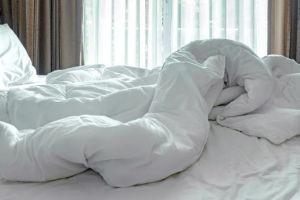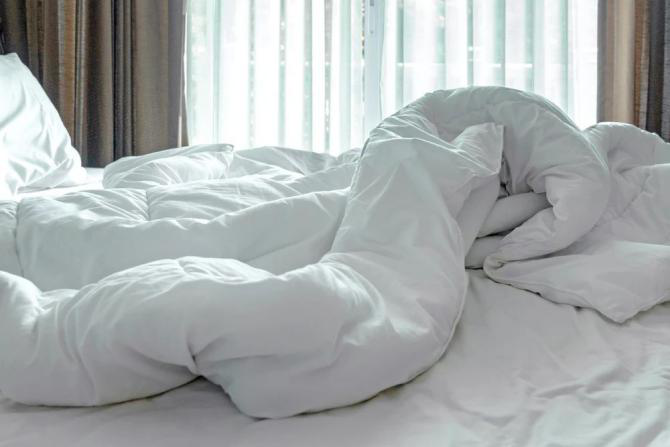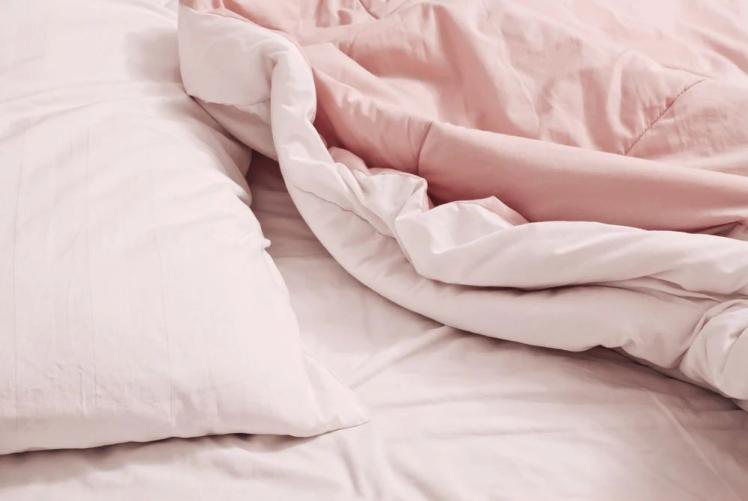
It is a blessing to be able to sleep comfortably until dawn. However, it is difficult to fall asleep, wake up early, sleep well…more and more people are suffering a “sleep crisis”.
Recently, a study published in the Journal of Clinical Sleep Medicine (JCSM), offered a tip for people who cannot sleep well:
Change a thick quilt for a month, your sleep quality may be improved.

Cover a thick quilt to help improve sleep quality
Researchers from Karolinska Institutet in Sweden recruited 120 participants with clinical symptoms of insomnia and at least one mental illness (such as bipolar disorder, generalized anxiety disorder, and major depressive disorder). These participants were randomly divided into 2 groups, each with 8 kg, 6 kg, or 1.5 kg blankets (control group), and they fell asleep under these blankets for 4 weeks.

Four weeks later, nearly 60% of the participants in the heavy blanket group reduced the severity of insomnia by more than half, and the insomnia remission rate was 42.2%; the effective rate of the control group was only 5.4%, and the remission rate was 3.6%
After the four-week experiment was over, the research team conducted a 12-month follow-up, and most participants continued to use heavier blankets.
The researchers found that after switching from the control group to the heavier blanket group, the participants’ insomnia symptoms were greatly reduced. After 12 months, 92% of heavy blanket users had positive changes, and 78% of participants had effective relief of their insomnia symptoms.
The researchers further analyzed that compared with people who sleep under a light blanket, people who sleep under a heavier blanket are nearly 20 times more likely to relieve insomnia, and not only the severity of insomnia is reduced, but the quality of sleep And daytime sleepiness has also been improved. Covered with a thick blanket can also reduce symptoms of depression and anxiety.
Researchers said that the reason why heavy blankets can relieve insomnia may be due to the pressure it exerts on different parts of the body, which can stimulate the sense of touch, muscles and joints, similar to the sensation of massaging acupuncture points.
Previous studies have shown that deep pressure stimulation can increase the parasympathetic nerve excitement of the autonomic nervous system while reducing sympathetic nerve excitement. It is believed to have a calming effect and can help the body relax.
All year round, the quilt has its “best weight”
Although studies have found that a thick quilt can help relieve insomnia and anxiety, it is not good if a quilt is too heavy or too light.
The quilt is too heavy: it will compress the chest, reduce lung capacity, and easily make the temperature of the quilt too high, leading to excessive metabolism, high energy consumption, increased sweat, easy cold, and fatigue after waking up.
The quilt is too light: the effect of thermal insulation is poor. The body surface is exposed to cold stimulation, the cerebral cortex is excited, it is difficult to sleep, or the sleep is not deep.

The weight of the quilt is not a one-size-fits-all standard, it is best to choose according to the season and quilt material.
It is recommended to pick 3 kg of quilts in winter, and blankets can be added according to the coldness.
For spring and autumn quilts, 1~1.5 kg is good, and the weight of the duvet is about half of the quilt.
In the heated north, the weight of the quilt can be adjusted according to the indoor temperature.
How to choose quilts of different materials?
There are many types of quilts on the market and their prices vary greatly. In fact, different quilts are suitable for different people, and the methods of washing and drying are also different.

Cotton quilt
Advantages: affordable price, good warmth and comfort, many people like the practical warmth it covers.
Disadvantages: Too heavy and pressing on the chest, It is not recommended for patients with cardiovascular and cerebrovascular diseases and those who can’t breathe easily.
Pick: take a shot. Good cotton is slapped without dust, soft and elastic, and has no peculiar smell.
Chemical fiber quilt
Advantages: low price and light quality.
Disadvantages: easy to generate static electricity, causing dry and rough skin. Especially in the northern winter with heating, which is inherently dry and is not recommended.
Pick: count the number of holes. The chemical fiber is divided into four holes, seven holes, nine holes, etc. The more holes, the richer the air, the better the air permeability and warmth retention.
Duvet
Advantages: Lightweight, the same volume quilt, the weight of the duvet is only 1/3 of the quilt, 1/2 of the wool quilt, good warmth retention, moisture absorption, and perspiration.
There are thousands of breathable triangular pores in the down fiber, and the surface layer contains waterproof grease, which automatically shrinks or expands with changes in temperature and humidity, quickly absorbs human sweat and moisture and volatilizes, keeping the quilt clean and the human body dry, especially suitable for the humid south and sweaty sleepers.
Disadvantages: Some people are allergic to down, it is best not for infants.
Pick: touch it. It has a high down content without thick hair stems when it is touched by the hand; the down smell of the quilt has a good cleanliness; the bulky, light weight and high fluffy.
Silk quilt
Advantages: The silk quilt is light, warm and comfortable, and the fiber is soft, which makes the cardiovascular system unloaded, and can sleep more comfortably. It also has a certain anti-mite, antibacterial and anti-mildew effect.
Disadvantages: poor elasticity, not thick, suitable for summer and autumn use. Middle-aged and infirm people may feel cold in winter and may feel unwell.
Pick: look at the color. The price of silk quilt is related to the content and type of silk. The higher the content, the higher the price. The price of mulberry silk is higher than that of tussah silk. Open the quilt when buying to see the quality of the silk, good silk is bright and uniform in color, long and flexible.
Wool quilt
Advantages: good drapability, close-fitting, suitable for people who sleep not very well. The wool fiber is elastically curled and has good moisture absorption, which can absorb moisture equivalent to 1/3 of its own weight. It is also antibacterial and anti-mite, suitable for rheumatism patients, sweaty people, babies and the elderly.
Disadvantages: strong moisture absorption, dry.
Pick: smell. It is best to buy 100% wool, no smell. If the wool is hard and brittle, the quality is poor.
Cleaning skills
The quilt should be cleaned every two weeks, and most allergens can be removed by soaking in hot water at 55°C for 5 minutes. However, frequent cleaning of the quilt is not recommended as it will affect the bulkiness.
Chemical fiber quilts and cotton quilts can be washed once a year.
The duvet core is washed once every 2 to 3 years.
Wool quilts and silk quilts can only be partially washed, or preferably not washed.
To sleep healthily, it is important to ventilate and dry regularly.
Drying skills
The quilt is heavier, releases moisture slowly, and needs to be exposed to the sun often for 3 to 4 hours each time.
The chemical fiber quilt is poorly hygroscopic, so it can be less exposed to the sun. The main purpose is to sterilize, and 2 to 3 hours is appropriate.
Wool is highly hygroscopic, susceptible to moisture and insects, and requires frequent exposure to sunlight. Use mild sunlight at 10 in the morning for 2 to 3 hours. Do not expose to direct sunlight to cause fiber damage.
Duvets and silks are easily damaged by fibers, so they are not suitable for drying. It is best to use weak sunlight in the morning and afternoon, or place them in a ventilated place to air dry for 1 to 2 hours.
Take a pat after sun exposure to shake off the mite limb fragments and excrement before use.
Comments